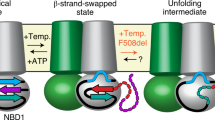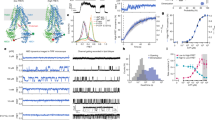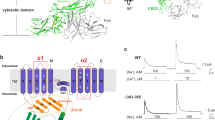Abstract
The regulatory (R) region of the cystic fibrosis transmembrane conductance regulator (CFTR) is intrinsically disordered and must be phosphorylated at multiple sites for full CFTR channel activity, with no one specific phosphorylation site required. In addition, nucleotide binding and hydrolysis at the nucleotide-binding domains (NBDs) of CFTR are required for channel gating. We report NMR studies in the absence and presence of NBD1 that provide structural details for the isolated R region and its interaction with NBD1 at residue-level resolution. Several sites in the R region with measured fractional helical propensity mediate interactions with NBD1. Phosphorylation reduces the helicity of many R-region sites and reduces their NBD1 interactions. This evidence for a dynamic complex with NBD1 that transiently engages different sites of the R region suggests a structural explanation for the dependence of CFTR activity on multiple PKA phosphorylation sites.
This is a preview of subscription content, access via your institution
Access options
Subscribe to this journal
Receive 12 print issues and online access
$189.00 per year
only $15.75 per issue
Buy this article
- Purchase on Springer Link
- Instant access to full article PDF
Prices may be subject to local taxes which are calculated during checkout





Similar content being viewed by others
References
Riordan, J.R. et al. Identification of the cystic fibrosis gene: cloning and characterization of complementary DNA. Science 245, 1066–1072 (1989).
Dawson, R.J. & Locher, K.P. Structure of a bacterial multidrug ABC transporter. Nature 443, 180–185 (2006).
Ostedgaard, L.S., Baldursson, O., Vermeer, D.W., Welsh, M.J. & Robertson, A.D. A functional R domain from cystic fibrosis transmembrane conductance regulator is predominantly unstructured in solution. Proc. Natl. Acad. Sci. USA 97, 5657–5662 (2000).
Dulhanty, A.M. & Riordan, J.R. Phosphorylation by cAMP-dependent protein kinase causes a conformational change in the R domain of the cystic fibrosis transmembrane conductance regulator. Biochemistry 33, 4072–4079 (1994).
Smith, P.C. et al. ATP binding to the motor domain from an ABC transporter drives formation of a nucleotide sandwich dimer. Mol. Cell 10, 139–149 (2002).
Lewis, H.A. et al. Structure of nucleotide-binding domain 1 of the cystic fibrosis transmembrane conductance regulator. EMBO J. 23, 282–293 (2004).
Rich, D.P. et al. Regulation of the cystic fibrosis transmembrane conductance regulator Cl- channel by negative charge in the R domain. J. Biol. Chem. 268, 20259–20267 (1993).
Chang, X.B. et al. Protein kinase A (PKA) still activates CFTR chloride channel after mutagenesis of all 10 PKA consensus phosphorylation sites. J. Biol. Chem. 268, 11304–11311 (1993).
Cheng, S.H. et al. Phosphorylation of the R domain by cAMP-dependent protein kinase regulates the CFTR chloride channel. Cell 66, 1027–1036 (1991).
Wilkinson, D.J. et al. CFTR activation: additive effects of stimulatory and inhibitory phosphorylation sites in the R domain. Am. J. Physiol. 273, L127–L133 (1997).
Vais, H., Zhang, R. & Reenstra, W.W. Dibasic phosphorylation sites in the R domain of CFTR have stimulatory and inhibitory effects on channel activation. Am. J. Physiol. Cell Physiol. 287, C737–C745 (2004).
Baldursson, O., Ostedgaard, L.S., Rokhlina, T., Cotten, J.F. & Welsh, M.J. Cystic fibrosis transmembrane conductance regulator Cl- channels with R domain deletions and translocations show phosphorylation-dependent and -independent activity. J. Biol. Chem. 276, 1904–1910 (2001).
Xie, J. et al. A short segment of the R domain of cystic fibrosis transmembrane conductance regulator contains channel stimulatory and inhibitory activities that are separable by sequence modification. J. Biol. Chem. 277, 23019–23027 (2002).
Csanady, L. et al. Severed channels probe regulation of gating of cystic fibrosis transmembrane conductance regulator by its cytoplasmic domains. J. Gen. Physiol. 116, 477–500 (2000).
Winter, M.C. & Welsh, M.J. Stimulation of CFTR activity by its phosphorylated R domain. Nature 389, 294–296 (1997).
Wright, P.E. & Dyson, H.J. Intrinsically unstructured proteins: re-assessing the protein structure-function paradigm. J. Mol. Biol. 293, 321–331 (1999).
Romero, P. et al. Sequence complexity of disordered protein. Proteins 42, 38–48 (2001).
Dunker, A.K., Obradovic, Z., Romero, P., Garner, E.C. & Brown, C.J. Intrinsic protein disorder in complete genomes. Genome Inform. Ser. Workshop Genome Inform. 11, 161–171 (2000).
Iakoucheva, L.M., Brown, C.J., Lawson, J.D., Obradovic, Z. & Dunker, A.K. Intrinsic disorder in cell-signaling and cancer-associated proteins. J. Mol. Biol. 323, 573–584 (2002).
Haynes, C. et al. Intrinsic disorder is a common feature of hub proteins from four eukaryotic interactomes. PLoS Comput. Biol. 2, e100 (2006).
Gadsby, D.C. & Nairn, A.C. Control of CFTR channel gating by phosphorylation and nucleotide hydrolysis. Physiol. Rev. 79, S77–S107 (1999).
Dyson, H.J. & Wright, P.E. Nuclear magnetic resonance methods for elucidation of structure and dynamics in disordered states. Methods Enzymol. 339, 258–270 (2001).
Bienkiewicz, E.A. & Lumb, K.J. Random-coil chemical shifts of phosphorylated amino acids. J. Biomol. NMR 15, 203–206 (1999).
Neville, D.C. et al. Evidence for phosphorylation of serine 753 in CFTR using a novel metal-ion affinity resin and matrix-assisted laser desorption mass spectrometry. Protein Sci. 6, 2436–2445 (1997).
Townsend, R.R., Lipniunas, P.H., Tulk, B.M. & Verkman, A.S. Identification of protein kinase A phosphorylation sites on NBD1 and R domains of CFTR using electrospray mass spectrometry with selective phosphate ion monitoring. Protein Sci. 5, 1865–1873 (1996).
Marsh, J.A., Singh, V.K., Jia, Z. & Forman-Kay, J.D. Sensitivity of secondary structure propensities to sequence differences between alpha and gamma synuclein: implications for fibrillation. Protein Sci. 15, 2795–2804 (2006).
Andrew, C.D., Warwicker, J., Jones, G.R. & Doig, A.J. Effect of phosphorylation on alpha-helix stability as a function of position. Biochemistry 41, 1897–1905 (2002).
Farrow, N.A. et al. Backbone dynamics of a free and phosphopeptide-complexed Src homology 2 domain studied by 15N NMR relaxation. Biochemistry 33, 5984–6003 (1994).
Schwalbe, H. et al. Structural and dynamical properties of a denatured protein. Heteronuclear 3D NMR experiments and theoretical simulations of lysozyme in 8 M urea. Biochemistry 36, 8977–8991 (1997).
Cohn, J.A., Nairn, A.C., Marino, C.R., Melhus, O. & Kole, J. Characterization of the cystic fibrosis transmembrane conductance regulator in a colonocyte cell line. Proc. Natl. Acad. Sci. USA 89, 2340–2344 (1992).
Picciotto, M.R., Cohn, J.A., Bertuzzi, G., Greengard, P. & Nairn, A.C. Phosphorylation of the cystic fibrosis transmembrane conductance regulator. J. Biol. Chem. 267, 12742–12752 (1992).
Lewis, H.A. et al. Impact of the deltaF508 mutation in first nucleotide-binding domain of human cystic fibrosis transmembrane conductance regulator on domain folding and structure. J. Biol. Chem. 280, 1346–1353 (2005).
Thibodeau, P.H., Brautigam, C.A., Machius, M. & Thomas, P.J. Side chain and backbone contributions of Phe508 to CFTR folding. Nat. Struct. Mol. Biol. 12, 10–16 (2005).
Csanady, L. et al. Preferential phosphorylation of R-domain Serine 768 dampens activation of CFTR channels by PKA. J. Gen. Physiol. 125, 171–186 (2005).
Dyson, H.J. & Wright, P.E. Coupling of folding and binding for unstructured proteins. Curr. Opin. Struct. Biol. 12, 54–60 (2002).
Pawson, T. Protein modules and signalling networks. Nature 373, 573–580 (1995).
Fuxreiter, M., Simon, I., Friedrich, P. & Tompa, P. Preformed structural elements feature in partner recognition by intrinsically unstructured proteins. J. Mol. Biol. 338, 1015–1026 (2004).
Oldfield, C.J. et al. Coupled folding and binding with alpha-helix-forming molecular recognition elements. Biochemistry 44, 12454–12470 (2005).
Howell, L.D. et al. Protein kinase A regulates ATP hydrolysis and dimerization by a cystic fibrosis transmembrane conductance regulator (CFTR) domain. Biochem. J. 378, 151–159 (2004).
Mense, M. et al. In vivo phosphorylation of CFTR promotes formation of a nucleotide-binding domain heterodimer. EMBO J. 25, 4728–4739 (2006).
Csanady, L., Chan, K.W., Nairn, A.C. & Gadsby, D.C. Functional roles of nonconserved structural segments in CFTR's NH2-terminal nucleotide binding domain. J. Gen. Physiol. 125, 43–55 (2005).
Ma, J., Zhao, J., Drumm, M.L., Xie, J. & Davis, P.B. Function of the R domain in the cystic fibrosis transmembrane conductance regulator chloride channel. J. Biol. Chem. 272, 28133–28141 (1997).
Nash, P. et al. Multisite phosphorylation of a CDK inhibitor sets a threshold for the onset of DNA replication. Nature 414, 514–521 (2001).
Pufall, M.A. et al. Variable control of Ets-1 DNA binding by multiple phosphates in an unstructured region. Science 309, 142–145 (2005).
Naren, A.P. CFTR chloride channel regulation by an interdomain interaction. Science 286, 544–548 (1999).
Ko, S.B. et al. Gating of CFTR by the STAS domain of SLC26 transporters. Nat. Cell Biol. 6, 343–350 (2004).
Sattler, M., Schleucher, J. & Griesinger, C. Heteronuclear multidimensional NMR experiments for the structure determination of proteins in solution employing pulsed field gradients. Prog. Nucl. Magn. Reson. Spectrosc. 34, 93–158 (1999).
Kanelis, V., Forman-Kay, J.D. & Kay, L.E. Multidimensional NMR methods for protein structure determination. IUBMB Life 52, 291–302 (2001).
Delaglio, F. et al. NMRPipe: a multidimensional spectral processing system based on UNIX pipes. J. Biomol. NMR 6, 277–293 (1995).
Johnson, B.A. & Blevins, R.A. NMRView—a computer program for the visualization and analysis of NMR data. J. Biol. NMR 4, 603–614 (1994).
Acknowledgements
We thank R. Muhandiram and L.E. Kay for technical assistance with NMR experiments, D.F. Hansen for assistance with NMR data analysis using Fuda, C.E. Bear and T. Mittag for many helpful discussions, and J.W. Hanrahan for critically reading the manuscript. This work was funded by grants from the Canadian Cystic Fibrosis Foundation and the Canadian Institutes of Health Research to J.D.F.-K. and from the US National Institutes of Health (DK49835) and the Robert Welch Foundation to P.J.T. J.M.R.B. was supported by scholarships from the Natural Sciences and Engineering Research Council of Canada.
Author information
Authors and Affiliations
Contributions
J.M.R.B. designed experiments, expressed and purified R region, performed NMR experiments, analyzed data and wrote the manuscript; R.P.H. expressed and purified NBD1; V.K. analyzed data; W.-Y.C. analyzed NMR data; P.H.T. generated the NBD1 construct and advised on NBD1 purification; P.J.T. contributed new reagents and analyzed data; J.D.F.-K. directed the study, designed experiments and wrote the manuscript. All the authors edited the manuscript.
Corresponding author
Ethics declarations
Competing interests
The authors declare no competing financial interests.
Supplementary information
Supplementary Text and Figures
Supplementary Figures 1 and 2, Supplementary Tables 1 and 2. (PDF 398 kb)
Rights and permissions
About this article
Cite this article
Baker, J., Hudson, R., Kanelis, V. et al. CFTR regulatory region interacts with NBD1 predominantly via multiple transient helices. Nat Struct Mol Biol 14, 738–745 (2007). https://doi.org/10.1038/nsmb1278
Received:
Accepted:
Published:
Issue Date:
DOI: https://doi.org/10.1038/nsmb1278
This article is cited by
-
ABC-transporter CFTR folds with high fidelity through a modular, stepwise pathway
Cellular and Molecular Life Sciences (2023)
-
Systematic discovery of biomolecular condensate-specific protein phosphorylation
Nature Chemical Biology (2022)
-
Phosphorylation-dependent modulation of CFTR macromolecular signalling complex activity by cigarette smoke condensate in airway epithelia
Scientific Reports (2019)
-
VX-770-mediated potentiation of numerous human CFTR disease mutants is influenced by phosphorylation level
Scientific Reports (2019)
-
Specific metallo-protein interactions and antimicrobial activity in Histatin-5, an intrinsically disordered salivary peptide
Scientific Reports (2019)



